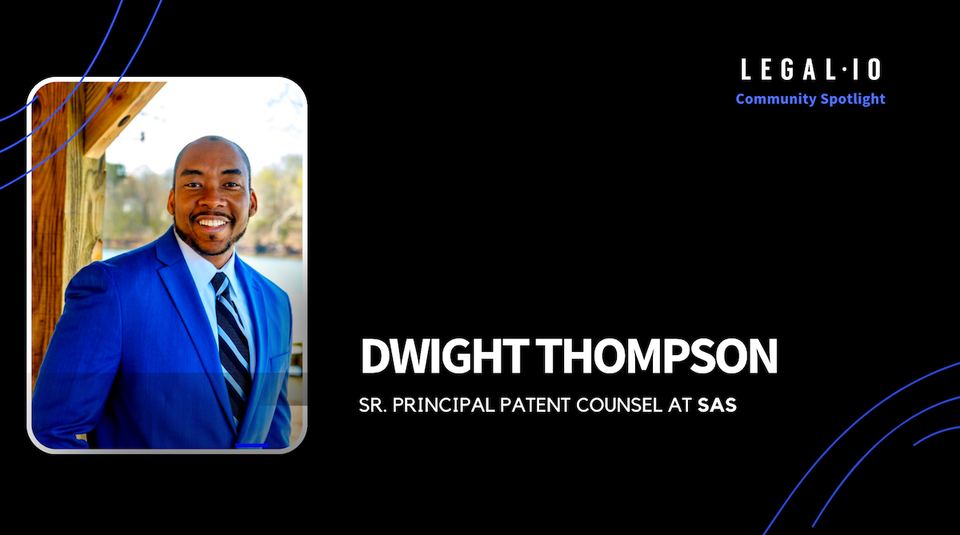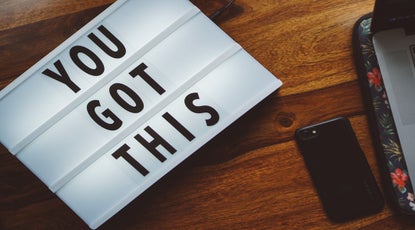Welcome to the next episode of Legal.io Community Spotlight, a series in which we highlight the careers and experiences of some of the most impressive legal and legal operations professionals working in-house.
In this episode, we explore the career journey of Dwight Thompson, Senior Principal Patent Counsel at SAS. Dwight talks about how far current AI still has yet to come in order to compete with the business expertise successful patent attorneys possess. Pieter and Dwight cover:
- Dwight's career journey to date
- Key responsibilities in his role as Senior Principal Patent Counsel at SAS
- Key challenges and lessons learned in his role over time
- AIs uphill climb in order to meaningfully compete with the business expertises patent attorneys possess.
Pieter Gunst
Hi, everyone. My name is Pieter Gunst and I am so delighted today to shine the spotlight on the career of Dwight Thompson, Senior Principal Patent Counsel at SAS. Dwight, thank you so much for joining me here today.
Dwight Thompson
Yes, glad to be here.
Pieter Gunst
Dwight, I haven't had a chance to talk with many patent attorneys as part of this series, and I'm just really curious to hear a little bit more about your journey becoming the Senior Principal Patent Counsel at SAS and maybe tell us a bit about the company as well as part of that.
Dwight Thompson
Let me start with the company. SAS is a data analytics company. It's been around for about 47 years. It started around when Microsoft started, so it’s an older company and it started out of NC State. The founders are from NC State. We've been doing data analytics before it became cool to do data analytics. That’s what we like to say.
For myself, I'm from North Carolina. Originally, I went to undergrad at N.C. State University in Raleigh and my undergrad was in electrical computer engineering. From there I went to Stanford for grad school and I got my masters and PhD there. When I was in grad school, I actually worked in circuit design. That was my thesis topic. I was a mixed-signal chip designer when I was there, working on a chip design related to something I was doing at SLAC, the Stanford Linear Accelerator Center there.
So when I finished Stanford, I got a job and moved down to San Diego (also as an integrated circuit designer). From there, I got exposed to patent law by a patent lawyer at the company. I didn't really know much about patent law and surprisingly a lot of patent lawyers discover patent law later, not initially. It’s like happenstance at some point in your career. So, that's when I discovered it. When I was at a company, I met a patent lawyer and I thought about what they did and I was thinking, “Maybe I could try this. I'm still young and I still can do circuit design but maybe I'll just try it”.
So, I decided to join a law firm. Took the patent bar, passed that, and decided to go to law school. I went to the University of San Diego School of Law. Worked during the day and went to law school at night. When I finished my degree, I ended up staying with the same firm. I stayed at the same firm for about ten years.
Pieter Gunst
That's a long time.
Dwight Thompson
Yeah, it’s a long time. I enjoyed my time at the firm. I was initially at the San Diego office and I moved to the DC office by the time I got done. I got exposed to SAS - when I was at NC State. It's a locally well-known, well-respected company in the Triangle area. When I was in DC, my former TA at NC state worked at SAS and I found out through her that there was an opening here at SAS in the patent group, so I decided to apply for it. I got the job and ever since then I've been to SAS and it's been a great experience.
Pieter Gunst
I have heard quite a lot about the company because my co-founder Hannah has a family member, now retired, [who] essentially worked at SAS for all her life. I've heard about the amazing campus and I guess more importantly about some of the trendsetting work that the company has done and almost acted as an inspiration for the Google’s of this world. Which is quite an interesting aspect of the company. Now, it's so fascinating to me, of course, we share a Stanford background, [and] I know SLAC very well. And, of course in patents this will be more common, but why would you even consider going into the legal field? You said, “Ha, this looks kind of interesting”. What was that thinking about? Was it a hunch? Was it like a passion that you had? How did that come to be?
Dwight Thompson
That's a great question. Actually, I just wanted something that was a little more dynamic. The process of chip design. It can take a while to do a chip design, a year or two years to do a chip design. I wanted something a little bit more dynamic from day to day and also something with a little bit more human interaction.
Becoming a patent lawyer is - you’re not so much of a specialist, you’re more of a technologist. You see a lot of different technologies. A lot of different inventions and ideas and you talk to a lot of different people. I think it's a pretty exciting thing from day to day from a work perspective.
Pieter Gunst
As a legal technologist, that rings very true to me as well. Dwight, in this role, what are the key responsibilities that inform your work? What does a day look like?
Dwight Thompson
The day can change a lot from day to day. There's not a typical day to day. Just in general, for patent lawyers, it depends on your company. What your company does and what type of field you're in; whether you're biotech or are you in a hardware, a company, a software company. It just depends on the type of work you do.
One thing that I do a lot is patent prosecution, which is the process of getting patents through the patent office. I have a patent harvesting process in the company, in which I get embedded in the R&D and sales teams that kind of figure out the latest and greatest of what they're doing and then get those innovations so that we can kind of capture those for patents. As well as reviewing any potential litigation or litigation threats.
Also, in a community just trying to do different things in the legal field, straight in a local patent bar. I talk to law students a lot. We have law student interns, working on patent policy with the patent office. And just kind of strengthen the patent system overall. Those are things that I do in my patent role, but I also do other things outside of my patent role. Contracts, things relating to IP planning, which are contracts. Promote innovation within the company, making sure everyone is aware that innovation never stops. You always have to continue doing it even when you finish work. Work on open source issues, diversity/inclusion goals and policies within a company, even advising some executives with issues that come up as well. So those are some of the things I do in my role.
Pieter Gunst
Very exciting, very interesting and also very cool to hear that you’re giving back. That you are consciously working with up and coming future patent lawyers and teaching them. I'm kind of imagining you sitting in the lab also pointing at the engineers. “Hey, that's an invention, guys”, that's pretty interesting as well in terms of the interaction.
Now, in this role, conversely, that sounds very exciting. What are some of the key challenges or maybe a key challenge and what have you learned from it along the way?
Dwight Thompson
I will say, one challenge was when I started at SAS. Switching from being a lawyer at a firm to an in-house attorney, which is different. It's a completely different lens. As a patent attorney, you can work in several different roles. They tend to be; you can work at the patent office or with the government in some government role with patents, you can work at law firms mainly during a patent prosecution or some type of patent litigation or even with a patent trial and appeals board, and you can also do in-house. That's the three big circles, if you're trying to do some type of Venn diagram of what we do.
So in terms of in-house, I had a transition to think that I don't have many clients, I have one client. I have to do the best I can for this one client. And instead of being someone that generates money for the firm or company, you're a call center. You have to keep that in mind. There are certain companies that can monetize their patents or patent portfolio. But we're not one of those companies. So, basically you’re a call center, and you have to think about using the money that you have to budget wisely. And you also kind of think about your inventors as being your customers. You want them to have a good experience, an enjoyable experience and also to make them feel rewarded in terms of actually getting a patent and also patent incentives, so they can be repeat customers. You want them to come back, because that will help the company overall. You want to have a good relationship with your outside counsel as well. So the people that you're reviewing that work and you’re advising; you want them to not only do work but also provide them with good, meaningful work so that they can enjoy working with you and also they can get compensated well and do their best.
Pieter Gunst
Interesting. So a very people-centric role in that sense because lawyers are often known as the “Department of No”, but here you play a facilitating role. And it's interesting to hear you talk about, you or the department does a cost center because of course there's a tremendous value in liability reduction but it's maybe harder to show than here is the revenues generated from a patent portfolio that's used commercially.
That's intriguing. Thank you for that insight. Now, Dwight, the other thing that I'm very interested in, clearly, you must be doing something right because you've been there for a while and you've been in the industry, generally, given your background in the firm, for a while. I'm wondering, like roughly the past two decades, especially in a world where technology has evolved so fast - What's been the impact of those evolutions on the role? What has changed? What has remained the same?
Dwight Thompson
That's just a great question, because the role depends on what you do as a patent attorney. Whether you're in telecom or semiconductors or biotech or pharma. There's certain times when there's a lot of activity, there's a lot of innovation and there's a lot that happens in your field that you have to follow. So you have to capture those innovations.
And there's other times where there is a lot of litigation activity they have in those areas. Maybe a company is going out of business and they don't have anything left, but their patent portfolio to monetize. So they start suing other companies for money. At that point, there's a lot of activity in that particular technical area. You have to look at trends that happen over time in terms of particular industries.
One thing that's changed a lot is the creation of the details of the PTAB, the Patent Trial and Appeal Board. A new venue for validating patents. That's something that's new in the past decade.
The popular districts for litigation [in which] people like to litigate. East and West districts of Texas, and also Delaware. Some things that are challenges are just the budgets for prosecution, they're fairly flat. They've been flat for a while. So a lot of times in this growing inflationary environment, it gets tougher and tougher to do that type of work for a flat budget that really hasn't gone up much in the past.
Pieter Gunst
And is that driven by the cost of outside counsel to a large extent or is that you? How should think about that?
Dwight Thompson
In the industry, it's more driven by the cost of outside counsel; that gets more expensive. Lawyers want to get paid more over time, as they should. But the amount of money that companies can allocate for getting patents can only increase so much. There's that tension there, because companies want X amount of patents per year, but sometimes some of the financial people in the companies don't realize that this is how much it's going to cost. These are costs that are going to go up each year by a certain amount. So overall in the industry, those budgets haven't been increased as much as they probably should be increased.
Pieter Gunst
Fascinating. I mean, I'll ask this in the age of ChatGPT, but maybe more generally, are you seeing a world where (let’s maybe focus on the outside counsel piece) where there is an increased efficiency through technology? Is that one way that outside counsel is actually managing this, or at least today, not yet as much?
Dwight Thompson
Yeah, that's a very interesting question, because there's a lot of chatter about ChatGPT. Right now, AI cannot draft a patent application as well as an attorney yet, especially when it's claiming an invention when they get to the claim section of the patent. But eventually, it might do well, especially for simple inventions. It can be used as a first draft to put something together. But, you know, it may not ever get to the point where you get the nuances of the application to make it more robust. Like if it’s ever litigated or challenged. It won't understand what examiners like to see like special buzzwords in your field examiners like to see to get the cases allowed.
Also that may have errors that may be fatal. The wording in patents needs to be very precise, like the claims that are ever construed and examined in litigation, then if there's an error in how some words or terms or interpret it, they can really destroy your patent. And AI may not understand that as well. AI will probably never understand your underlying business objectives and reasons for filing an application to begin with.
So, I will say you get what you pay for, right? If you want something inexpensive that may have some errors that might be not as strong as litigating it, then you can go with AI.
Pieter Gunst
I love that answer. And yeah, to your point, it's hard to imagine a world where it does it and it doesn't need review. But maybe there's some efficiencies to be had in a first draft. And then, of course, to the extent that AIs are trained on historical data, but patents are really about novel things. It might also not capture as much [of] that kind of information. That is super intriguing.
I am so grateful for you spending a little bit of time with me to talk about your career journey and some of the things that are happening on the frontier. I really enjoyed this conversation. Thank you very much.
Dwight Thompson
Thank you as well.
--
Do you work in-house and are you interested in sharing your career journey and experiences with the community? Apply here to be featured in a Community Spotlight.
Are you a legal operations professional or considering entering the field? Join Legal.io to discover legal operations jobs, resources and more.










